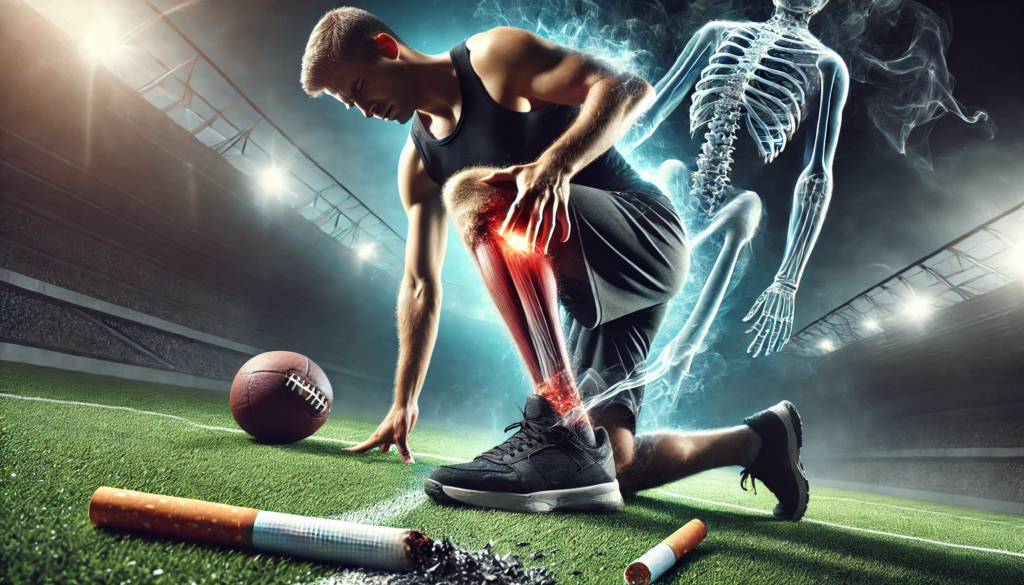Quitting smoking is not just a question of general health, but also a crucial decision for improving physical performance and sporting activities. Numerous studies show that smoking has a direct impact on the risk of injury, particularly among athletes. But why can smoking have such a serious impact on physical effort? Let’s explore the links between tobacco consumption and physical performance, and how smoking cessation, in particular through laser auriculotherapy, can change the game for athletes and those who enjoy physical activity.
The impact of smoking on sports performance
To understand how tobacco can impair physical performance, it’s essential to examine its effects on athletes’ bodies. Let’s explore in detail the different systems affected by tobacco consumption.
A respiratory system put to the test
When it comes to sport, breathing plays a fundamental role. And yet, the consequences of smoking are obvious: altered gas exchange, reduced blood oxygenation and diminished respiratory capacity. These factors lead to a drop in sporting performance, and increase the feeling of fatigue during exercise.
A recent study in France revealed that young athletes who smoke regularly have a significantly lower level of performance than those who adopt a healthy lifestyle. Trainers often stress the importance of a smoke-free lifestyle to maximize results and limit the risk of injury.
The long-term effects of smoking are not limited to reduced performance. Chronic respiratory diseases, such as COPD, affect many athletes who smoke, and can lead to a significant increase in cases of premature death from lung problems.
Take the example of an amateur runner who smokes regularly. Not only will he reach his physical limits more quickly, but he will also be more vulnerable to muscular injury due to poor tissue oxygenation, which is essential during intense activity. High-level athletes, on the other hand, insist on the importance of a strict lifestyle, excluding tobacco, to maintain their performance.
Renowned coaches such as Didier Deschamps often stress that prevention is key for young athletes. In a recent interview, he said, “A player who takes care of his body, avoids harmful products like tobacco and follows rigorous training, has every chance of succeeding at the highest level.”

Bone fragility accentuated by smoking
The world of tobacco is well known for its harmful effects on bone health. Smoking slows cell regeneration, which directly impacts bone density and increases the risk of fractures. For an athlete, this means increased danger when playing intense sports such as soccer or basketball.
A report published by injury prevention experts in France shows that smokers are almost twice as likely to suffer stress fractures. These data reinforce the importance of adopting a tobacco-free lifestyle, especially among young people involved in competitive sports.
Professional trainers often recommend that athletes follow specific programs aimed at improving their general health, including quitting smoking. Combined with a balanced diet and regular exercise, this can reduce the risk of injury and increase sporting longevity.
Another concrete example: professional cyclists who continue to smoke or use electronic cigarettes. In addition to facing more frequent fractures, they experience prolonged recovery after injury, which can compromise their return to normal practice.
You may also be interested in this article: How does laser therapy work to stop smoking?
Why does smoking increase the risk of injury?
Beyond its impact on overall performance, smoking directly influences recovery and susceptibility to injury. Let’s find out how these mechanisms play out in athletes.
Slower healing
After an injury, the body repairs itself through blood circulation and the supply of nutrients. However, smoking restricts blood circulation and reduces the ability of tissues to regenerate. An injured tennis player, for example, will take much longer to heal if he is a smoker.
What’s more, the toxic components of cigarettes, such as carbon monoxide, disrupt muscle oxygenation. This not only increases the risk of injury, but also complicates the return to optimal sporting performance. Top-level athletes therefore avoid nicotine to preserve their capacity for effort and physical endurance.
Studies have shown that athletes who stop smoking improve their oxygen capacity in the months following cessation. These data confirm the positive effect of smoking cessation on overall health and sporting performance.
Chronic inflammation aggravated by smoking
Smoking causes a generalized state of inflammation. In athletes, this translates into increased susceptibility to tendonitis and other chronic injuries. Rugby players, for example, are often exposed to microtrauma. By aggravating inflammation, tobacco prolongs pain and downtime, having a negative impact on their sporting activities.
A study carried out on smoking athletes also highlighted a higher rate of muscle injury, with significantly prolonged recovery periods. Coaches often stress that young athletes need to be made aware of the dangers of smoking to avoid long-term complications.
Smoking cessation as a solution to prevent injuries
For athletes wishing to regain optimum health, quitting smoking represents a major lever. Several solutions exist to support this process, including innovative methods such as auriculotherapy.
The gentle method of laser auriculotherapy
Quitting smoking is no easy task, but there are effective, non-invasive solutions. Laser auriculotherapy uses precise points in the ear to regulate nicotine cravings. By stimulating these areas, the body regains balance and smoking cessation becomes more accessible.
Many former sports smokers testify to the benefits they have derived from this method. For example, Julie, a marathon runner, says: “I’d tried everything, including hypnosis, to quit smoking. But it was thanks to laser treatment that I was able to say goodbye to electronic cigarettes and nicotine without stress or weight gain.”
Multiple benefits of quitting smoking
Stopping smoking brings rapid improvements. Within a few weeks, the lungs begin to regenerate, and sporting performance increases significantly. What’s more, the money saved by giving up smoking can be reinvested in sports equipment or quality training sessions.
Recent data also show that prevention plays a crucial role in helping young people avoid falling into smoking. Products such as electronic cigarettes, while perceived as an alternative, do not eliminate the risks associated with nicotine on overall health.
Towards a tobacco-free sporting future
Envisioning a future where athletes no longer suffer the effects of tobacco is an ambition within reach. With targeted actions and appropriate support, it is possible to combine performance and well-being.
The link between smoking and sports injuries is undeniable. Smoking not only weakens the body, but also limits sporting ambitions. For any athlete, amateur or professional, smoking cessation is an essential step in preventing injury and optimizing physical performance.
If you’re looking for a gentle, effective way to say goodbye to the world of tobacco, why not try laser auriculotherapy? You may be surprised at the results.
Conclusion: Towards a global commitment to health
Quitting smoking is much more than avoiding injury. It’s about choosing a healthier, more active and more satisfying life. By taking care of your body and preserving your capacity for effort, you’re paving the way for new sporting performances and challenges. To take things a step further, why not explore different weaning solutions, such as coaching or dietary supplements, in addition to auriculotherapy? Change begins with a decision.
The media are talking about Mylasertabac :
sinactiv.fr, naturopat.fr, sante-et-beaute.fr, monparrainsante.com,hypnoandco.com,l-hexagone.fr, mondentistechampigny.fr, france-pharmacies.fr, santeplusmag.com
